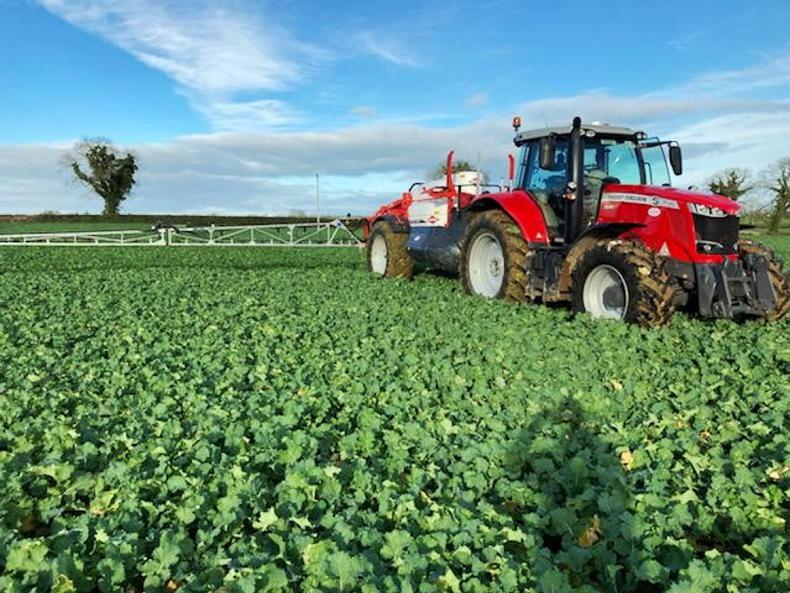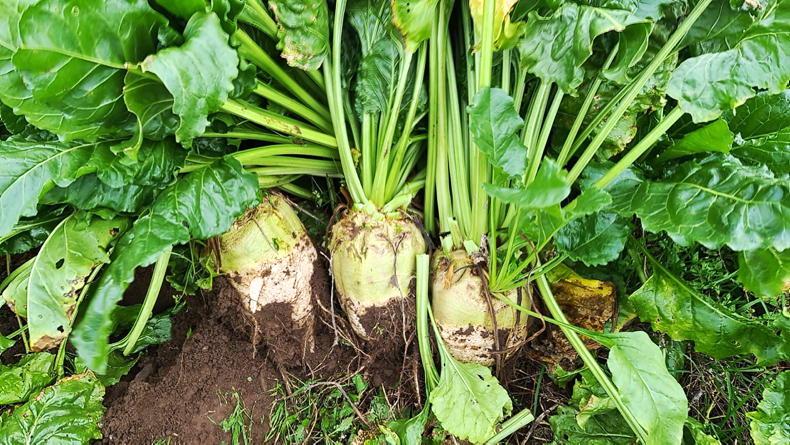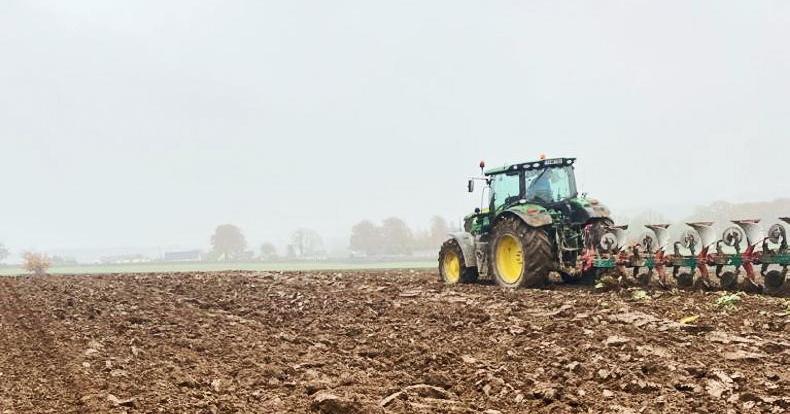Mallow, Cork
When talking to John this week, he was in the middle of blowing down the combine and balers ahead of winter storage. The machines will be greased and stored inside before being washed next year.
The mild weather means that crops are still growing, John says. Crops on compacted areas are beginning to show signs of yellowing, however. He says that aphids are a real concern. He is in a high-pressure region and the mild autumn temperatures mean that aphids are likely to be active, he remarks. He applied an aphicide on his winter barley crops two weeks ago.
Ground conditions remain very good for the time of year, John says. He runs 650 tyres on his sprayer this time of year and didn’t mark the field once when spraying. He says that slugs are active in some areas but doesn’t plan on applying slug pellets.
Rainfall amounts have been relatively low for the time of the year. Around 108mm of rain fell over the past 30 days, little of which fell in November. The lowest nighttime temperature reached 2.2°C on 30 October but daytime temperatures hit 17°C on 1 November.

John spraying his winter oilseed rape this week.
Crops
All crops are doing very well, he says. He sowed the last of his winter oats three weeks ago. The Husky crop was drilled at 180kg/ha and is likely to receive a post-emergence spray of DFF 0.2l/ha this week targeting chickweed.
His winter oilseed rape is beginning to slow down after a period of vigorous growth. The crop is now at wellie boot height explains John. He applied Prosaro (0.8l/ha) during the week.
Elsewhere he is steadily moving straw from his farm to customers sheds. All of his straw is sold but he stores an amount for customers each year. He is also selling some grain which is in store.
John says he will wait to next spring before purchasing fertiliser. He says that he will likely cut back on application rates of N, P and K as a result and try and use slurry where possible.
Durrow, Laois
Seamus was about to head to a discussion group meeting when talking to him this week.
The focus of the meeting was on farm business structures and their implications on tax, succession, management etc.
Seamus says the weather on his farm over the past few weeks has been exceptionally good.
The 90mm of rain which has fallen since this time last month has barely affected trafficability, he says, and any field work is being done with little damage.
He recently brought cattle indoors and there has been strong regrowth in those fields.
Seamus will apply an application of Naceto this week on to his winter barley crops and will add in DFF to target meadow grass. While temperatures are high, he questions if an aphicide is needed as he hasn’t seen any formal warnings to say they are active.

Seamus' fodder beet is bulking well and thinks the better crops are yielding 35t/ac.
The last of his winter barley was sown three weeks ago but has suffered considerable crow damage. The variety Faye was sown at 180kg/ha and has been regularly attacked by crows. Seamus thinks that neighbouring fields, which suffered even worse crow damage than his, will have to be resown. The rest of his winter barley crops are doing very well and are around the two- to three-leaf stage.
Boortmalt
Seamus thinks the recent €250/t forward price offered by Boortmalt is reasonable but questions if it will be enough to cover the increased cost of inputs next year.
“If you look at where it finished last year, it’s really just €12.50 on top of that” he says. “I estimate my input costs will increase by more than €60/t alone.
Seamus is also busy harvesting fodder beet. He says yields are good at around 35t/ac.
He uses contractors to harvest and wash his beet before selling it directly to farmers.
He is also concerned about the rise in input costs next year for growing beet crops.
Naas, Kildare
Tim sowed the last of his winter wheat last week. The crop was drilled into a recently harvested cabbage field and he says that ground conditions were excellent.
The Graham winter wheat crop was drilled at a rate of 200kg/ha but he increased this to 220kg/ha on the headlands. Like many areas, crow damage is particularly severe this year and the headlands of that field have been badly affected. However, most crops are advanced at this stage and have escaped the worst of the damage.
Slugs are also proving to be a problem this year, says Tim. He intends on applying a half-rate of Traxx slug pellets (2.5kg/ha) on to his winter wheat crops this week. The pellets are spread using a gator and spreader.

Tim ploughing the last headland for winter wheat in a field following cabbage.
Tim says he moved from a quad to a gator a number of years ago and was happy with this choice. He says a gator is considerably safer, but is easier to bog in wet ground when compared to a quad.
Mild
The mild weather has been great for growth but he is still questioning the need for an aphicide.
Tim says that whenever he inspected crops closely to try and find aphids he can’t find any. Some of his winter barley crops have already received an aphicide but the remainder are unlikely to need it at this stage.
His winter barley, rye and wheat crops are all coming along very well. His pre-emergence herbicide programme worked well this year but his winter oats have yet to be sprayed.
His 60ac of leafy turnip and fodder rape were sown later than planned and, as a result, have been slow to develop. They will likely be grazed by a neighbour’s sheep after Christmas.
Tim bought forward an amount of fertiliser but will have to buy more in the spring. He plans to cut back on P and K this year by as much as 50% in his stronger fields. He will reduce nitrogen rates slightly as well.

Mallow, Cork
When talking to John this week, he was in the middle of blowing down the combine and balers ahead of winter storage. The machines will be greased and stored inside before being washed next year.
The mild weather means that crops are still growing, John says. Crops on compacted areas are beginning to show signs of yellowing, however. He says that aphids are a real concern. He is in a high-pressure region and the mild autumn temperatures mean that aphids are likely to be active, he remarks. He applied an aphicide on his winter barley crops two weeks ago.
Ground conditions remain very good for the time of year, John says. He runs 650 tyres on his sprayer this time of year and didn’t mark the field once when spraying. He says that slugs are active in some areas but doesn’t plan on applying slug pellets.
Rainfall amounts have been relatively low for the time of the year. Around 108mm of rain fell over the past 30 days, little of which fell in November. The lowest nighttime temperature reached 2.2°C on 30 October but daytime temperatures hit 17°C on 1 November.

John spraying his winter oilseed rape this week.
Crops
All crops are doing very well, he says. He sowed the last of his winter oats three weeks ago. The Husky crop was drilled at 180kg/ha and is likely to receive a post-emergence spray of DFF 0.2l/ha this week targeting chickweed.
His winter oilseed rape is beginning to slow down after a period of vigorous growth. The crop is now at wellie boot height explains John. He applied Prosaro (0.8l/ha) during the week.
Elsewhere he is steadily moving straw from his farm to customers sheds. All of his straw is sold but he stores an amount for customers each year. He is also selling some grain which is in store.
John says he will wait to next spring before purchasing fertiliser. He says that he will likely cut back on application rates of N, P and K as a result and try and use slurry where possible.
Durrow, Laois
Seamus was about to head to a discussion group meeting when talking to him this week.
The focus of the meeting was on farm business structures and their implications on tax, succession, management etc.
Seamus says the weather on his farm over the past few weeks has been exceptionally good.
The 90mm of rain which has fallen since this time last month has barely affected trafficability, he says, and any field work is being done with little damage.
He recently brought cattle indoors and there has been strong regrowth in those fields.
Seamus will apply an application of Naceto this week on to his winter barley crops and will add in DFF to target meadow grass. While temperatures are high, he questions if an aphicide is needed as he hasn’t seen any formal warnings to say they are active.

Seamus' fodder beet is bulking well and thinks the better crops are yielding 35t/ac.
The last of his winter barley was sown three weeks ago but has suffered considerable crow damage. The variety Faye was sown at 180kg/ha and has been regularly attacked by crows. Seamus thinks that neighbouring fields, which suffered even worse crow damage than his, will have to be resown. The rest of his winter barley crops are doing very well and are around the two- to three-leaf stage.
Boortmalt
Seamus thinks the recent €250/t forward price offered by Boortmalt is reasonable but questions if it will be enough to cover the increased cost of inputs next year.
“If you look at where it finished last year, it’s really just €12.50 on top of that” he says. “I estimate my input costs will increase by more than €60/t alone.
Seamus is also busy harvesting fodder beet. He says yields are good at around 35t/ac.
He uses contractors to harvest and wash his beet before selling it directly to farmers.
He is also concerned about the rise in input costs next year for growing beet crops.
Naas, Kildare
Tim sowed the last of his winter wheat last week. The crop was drilled into a recently harvested cabbage field and he says that ground conditions were excellent.
The Graham winter wheat crop was drilled at a rate of 200kg/ha but he increased this to 220kg/ha on the headlands. Like many areas, crow damage is particularly severe this year and the headlands of that field have been badly affected. However, most crops are advanced at this stage and have escaped the worst of the damage.
Slugs are also proving to be a problem this year, says Tim. He intends on applying a half-rate of Traxx slug pellets (2.5kg/ha) on to his winter wheat crops this week. The pellets are spread using a gator and spreader.

Tim ploughing the last headland for winter wheat in a field following cabbage.
Tim says he moved from a quad to a gator a number of years ago and was happy with this choice. He says a gator is considerably safer, but is easier to bog in wet ground when compared to a quad.
Mild
The mild weather has been great for growth but he is still questioning the need for an aphicide.
Tim says that whenever he inspected crops closely to try and find aphids he can’t find any. Some of his winter barley crops have already received an aphicide but the remainder are unlikely to need it at this stage.
His winter barley, rye and wheat crops are all coming along very well. His pre-emergence herbicide programme worked well this year but his winter oats have yet to be sprayed.
His 60ac of leafy turnip and fodder rape were sown later than planned and, as a result, have been slow to develop. They will likely be grazed by a neighbour’s sheep after Christmas.
Tim bought forward an amount of fertiliser but will have to buy more in the spring. He plans to cut back on P and K this year by as much as 50% in his stronger fields. He will reduce nitrogen rates slightly as well.











 This is a subscriber-only article
This is a subscriber-only article











SHARING OPTIONS: